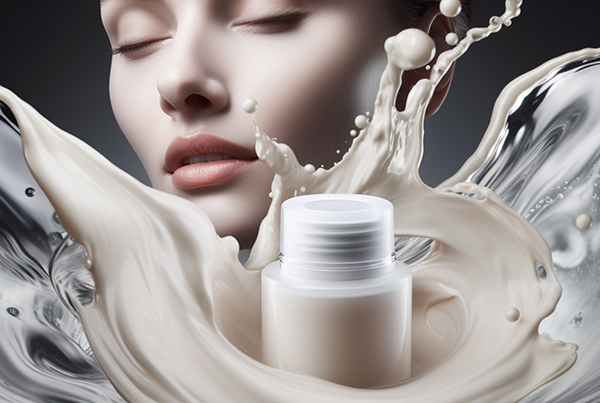1. Introduction
Ascorbyl Tetraisopalmitate is a very promising form of Vitamin C and your skin may benefit from using it. Even if you’ve never heard of it, it is very likely that you’ve used products that contain it.
In the post, I sometimes refer to Ascorbyl Tetraisopalmitate as “form of Vitamin C”, but “Vitamin C derivative” is more correct from a scientific perspective. But this is supposed to be a skin care blog, not a PhD thesis, right?
Long post? How unusual of me! Just find what you wish to read in the Table of Contents or read the bits in bold.
2. What is Ascorbyl Tetraisopalmitate?
Ascorbyl Tetraisopalmitate is a lipid-soluble Vitamin C derivative with potential benefits for the skin: wrinkle reduction, photoprotection, improved hydration and reduction of hyperpigmentation. Also known as Tetra-isopalmitoyl Ascorbic Acid, it is a rather stable form of Vitamin C. It is derived from Ascorbic acid and Isopalmitic acid.
Ascorbic acid is the water-loving form of Vitamin C found in fruit and veg. Isopalmitic acid is a fatty acid that should not be confused with Palmitic acid. It is found primarily in bacteria as well as in dairy and meat products.
Ascorbyl Tetraisopalmitate needs to be converted into Ascorbic acid in the skin to be beneficial.
3. Why you need Vitamin C in your skin care routine
Vitamin C occurs naturally in our skin as Ascorbic acid, where it provides antioxidant protection. Vitamin C levels tend to be lower in aged or photodamaged skin.
UV damage and exposure to pollutants are also associated with lower Vitamin C levels in the epidermis.
Ascorbic acid occurs naturally in plenty of fruit and veg. There are also plenty of Vitamin C supplements in the market. However, Vitamin C from food and supplements may not reach skin in quantities large enough to visibly improve skin.
This can be overcome by applying skin care products with Vitamin C directly on the skin. Ascorbyl Tetraisopalmitate can be beneficial for anyone looking to reap the benefits of topical Vitamin C.
4. Ascorbyl Tetraisopalmitate benefits for skin
Ascorbyl Tetraisopalmitate is not biologically active: it has to be converted to Ascorbic acid in the skin cells in order to benefit the skin. So, the well-known benefits of topical Ascorbic acid essentially apply to Ascorbyl Tetraisopalmitate too.
Research on Ascorbyl Tetraisopalmitate has shown that it:
- Has antioxidant properties.
- It protects skin from UVA and UVB damage.
- It triggers production of collagen.
- It has anti-inflammatory properties.
- It can improve hydration at a 1% concentration.
- It may improve skin texture.
- It may reduce hyperpigmentation at a 3% concentration.
Truth be told, most research on Ascorbyl Tetraisopalmitate is associated with the company that manufactures it! And some studies were in vitro, i.e, not on actual people.
Nonetheless, it is an ingredient worth experimenting with and it is very likely that it converts to Ascorbic acid in the skin.
Combinations with other active ingredients
In studies, Ascorbyl Tetraisopalmitate has been combined with the following ingredients:
- Hyaluronic acid. The combination reduced hyperpigmentation and improved hydration and elasticity.
- Bakuchiol and Melatonin. The combination improved wrinkleS and elasticity and reduced redness.
- Bioflavonoids, Vitamin A (Retinyl Palmitate) and Vitamin E. The combination had a photoprotective effect.
There’s potential bias in some of these studies. Why, oh why!? But I do think that a combination of those active ingredients can benefit the skin.
5. Stability of Ascorbyl Tetraisopalmitate
Ascorbyl Tetraisopalmitate is a rather stable Vitamin C derivative: it doesn’t oxidise fast, which means that it retains its potency for longer. This doesn’t mean that it doesn’t oxidize at all, as some websites claim: it is estimated to have a shelf life of approximately 6-12 months.
Its stability improves if it is combined with other antioxidants, such as Vitamin E and Vitamin A (Retinyl Palmitate).
However, just like with many skin care ingredients, its stability decreases at high temperatures. If you live in a very warm place, I suggest you store Ascorbyl Tetraisopalmitate products in the fridge.
If you’ve been using a product with Ascorbyl Tetraisopalmitate and you noticed a change of colour, then it’s begun to oxidize.
By the way, Ascorbyl Tetraisopalmitate is more stable than the similar-sounding Ascorbyl Palmitate.
6. Skin penetration of Ascorbyl Tetraisopalmitate
A common claim is that Ascorbyl Tetraisopalmitate penetrates skin easily because it is oil-soluble.
A study did find that Ascorbyl Tetraisopalmitate penetrates skin. As an oil-loving substance, it can permeate the skin lipids and be transported deeper into the skin. The study was in vitro -not on actual humans- but it was very well-conducted.
However, the same study also found that Ascorbyl Tetraisopalmitate penetrates the skin via hair follicles!
They researchers suggest that the hair follicles may be the best route for Ascorbyl Tetraisopalmitate to penetrate deeper into the skin.
Some substances penetrate more easily through the hair follicles. Bear in mind that smaller hair follicles do exist on our forehead and cheeks. You probably don’t need a hair transplant to improve the absorption of your skin care products.
That would be very impressive, though.
7. Conversion of Ascorbyl Tetraisopalmitate to Ascorbic acid
Ascorbyl Tetraisopalmitate needs to be converted to Ascorbic acid in order to be beneficial for the skin. As Ascorbyl Tetraisopalmitate, it has no antioxidant activity. The conversion happens via an enzyme in the skin cells called esterase.
Esterase only exists in living cells beneath the epidermis. This means that Ascorbyl Tetraisopalmitate has to penetrate deep into the skin in order to be converted to Ascorbic acid. This is likely to happen.
In a study on a human skin model, 84% of Ascorbyl Tetraisopalmitate was converted to Ascorbic acid. The study was funded by the company that manufactures Ascorbyl Tetraisopalmitate, though.
However, perhaps Ascorbyl Tetraisopalmitate offers benefits for the skin even if it is not fully converted to Ascorbic Acid. That seems to be the case with some other forms of Vitamin C.
8. Ascorbyl Tetraisopalmitate vs Ascorbic acid
Ascorbic acid had a more pronounced anti-aging effect than Ascorbyl Tetraisopalmitate in a study. However, the study was conducted on human skin cells -fibroblasts-, not on actual humans. So, it is difficult to predict if Ascorbic acid is better in real-life scenarios.
Everyone’s skin is different. For some people, Ascorbic acid will work better than Ascorbyl Tetraisopalmitate and vice versa.
8.1 Potential pros of L-ascorbic acid
- Backed by way more research than Ascorbyl Tetraisopalmitate.
- Needs no conversion to be active.
- It is the naturally occurring form of Vitamin C. However, Ascorbic acid in skin care products and supplements is synthetic, but that’s not a problem.
- Relatively stable in water-based formulations with a highly acidic pH.
- Also available in water-free solutions, usually silicone-based, that are often less irritating and more stable than water-based ones.
- Can penetrate skin, despite claims by some beauty brands.
8.2 Potential pros of Ascorbyl Tetraisopalmitate
- May penetrate skin more efficiently than Ascorbic acid.
- Less likely to irritate sensitive skin because it doesn’t need to be formulated in a very acidic pH.
- Since it’s less likely to irritate, it is easier to combine with Retinol, Glycolic acid and other potentially irritating ingredients.
- Less prone to oxidation than Ascorbic acid with a longer shelf-life. Water-based Ascorbic acid products that have been sitting in the shelves too long will have lost a lot of their potency.
8.3 Claims by beauty brands
Some brands claim that Ascorbic acid is the only form of Vitamin C that works because it occurs naturally in the human body. Other brands claim that you should use Ascorbyl Tetraisopalmitate because it is the only form that penetrates the skin.
I suggest you don’t get carried away by marketing that sounds reassuringly scientific. Brands often reference only the studies that will convince you to buy their products and they forget the rest!
I am convinced that both Ascorbic Acid and Ascorbyl Tetraisopalmitate have benefits for the skin. But everyone’s skin is different and your best bet is to experiment to find what works for you.
If you can’t decide, you can have the best of both worlds: Just use Ascorbic acid in the morning and Ascorbyl Tetraisopalmitate in the evening. Using them simultaneously is also fine.
9. Safety of Ascorbyl Tetraisopalmitate
Ascorbyl Tetraisopalmitate has a very good safety profile. It is very unlikely to cause irritant or allergic reactions, according to the CIR (Cosmetic Ingredient Review).
You may have read online that there are studies that Ascorbyl Tetraisopalmitate causes irritation. Well, there have been two reports of contact dermatitis. And both patients had a history of atopic dermatitis. That’s no big deal!
There isn’t a single ingredient that won’t cause irritation or allergic reactions to some people.
10. Ascorbyl Tetraisopalmitate Vs Tetrahexyldecyl Ascorbate
It is often thought that Ascorbyl Tetraisopalmitate and Tetrahexyldecyl Ascorbate are two different names for the same form of Vitamin C. It seems that this is false: they are not the same thing.
Amanda, the cosmetic chemist behind the excellent Realizebeauty blog, has explained what’s going on in a post. Simply put, these two chemicals share some similarities, such as their molecular weight, but they have different structures. So they may not have the exact same effect on your skin.
However, I guess they may have similar chances of converting to Ascorbic acid in the skin.
According to Amanda, Ascorbyl Tetraisopalmitate is more expensive for two main reasons: it is more difficult to manufacture and its efficacy is supported by more studies.
I totally agree with that. In my research for this post, I found more research on Ascorbyl Tetraisopalmitate.
A confusing situation for consumers
Even some reliable blogs and skin care brands treat these two Vitamin C forms as the same thing. This means that, if you buy a product with Ascorbyl Tetraisopalmitate, it may actually contain Tetrahexyldecyl Ascorbate and vice versa.
Perhaps there are bigger problems in life. Or maybe not? If you’re as obsessed with skin care ingredients as I am, it’s Armageddon.
So how can you find out what’s the actual Vitamin C in your skin care products; I guess you can always contact a company’s customer service and pray for an honest response. Or you can ask a psychic.
For more information, click here to read Amanda’s post.
11. Ascorbyl Tetraisopalmitate and Niacinamide
As I said in my post on Niacinamide and Vitamin C, the vast majority of people won’t experience issues from combining Ascorbic acid with Niacinamide. That’s even less likely to happen from the combination of Ascorbyl Tetraisopalmitate with Niacinamide.
The combination of Ascorbic Acid with Niacinamide was rumoured to be bad largely because of the very acidic pH of Ascorbic Acid. The pH of products with Ascorbyl Tetraisopalmitate is typically less acidic, anyway.
This may be a great combination for hyperpigmentation. Vitamin C and Niacinamide have a different mode of action against hyperpigmentation. So, the combination may have a synergistic effect against stubborn brown spots.






